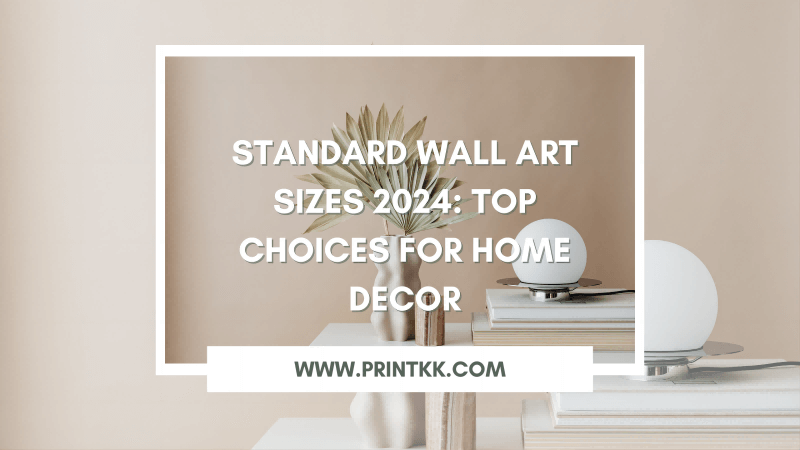
Are you overwhelmed by the choice of wall art sizes? Choosing the wrong size can throw off your entire room's aesthetic. With standard wall art sizes, you can effortlessly match art to any room's dimensions.Our guide simplifies these choices, showing you how to enhance your space's beauty and harmony with perfectly sized art pieces for any setting.
Introduction to Standard Wall Art Sizes
When venturing into the realm of wall art for home decor, understanding the standard sizes available is a cornerstone of successful interior design.This is where art meets strategy, creating opportunities to blend aesthetic appeal with precise market fit.
Standard wall art sizes offer a framework within which creativity can flourish. For instance, smaller sizes such as 8x10 inches are ideal for creating intricate galleries or adding a subtle touch to a personal workspace.
On the other end of the spectrum, large pieces, say 40x60 inches, serve as magnificent centerpieces that can completely redefine a room's ambiance.
This strategic approach not only enhances interior designs but also boosts consumer satisfaction and engagement, making it a critical aspect of the print-on-demand industry.
Trends in Wall Art Sizes for 2025
In 2025, the trend for wall art sizes continues to emphasize both aesthetic appeal and strategic placement within interior spaces. An important guideline for choosing wall art is to ensure that it occupies approximately 60% to 75% of the available wall space, which is not obstructed by furniture or other decor elements.
As we look ahead to 2025, the landscape of wall art sizes is seeing some exciting shifts, tailored to meet both aesthetic and practical demands of a diverse clientele.
Larger canvas prints are becoming increasingly popular, aligning with the trend for more dramatic and eye-catching pieces in both residential and commercial spaces.
There's a rising interest in smaller, more versatile wall art sizes. This trend reflects a broader movement towards personalized and adaptive decor solutions, where art is not just seen but experienced at a closer, more intimate level.
Most Popular Standard Wall Art Sizes
Heading into 2025, two particular sizes of wall art stand out for their popularity among various consumer segments, from entrepreneurs to home decorators.
The 18x24 inches size remains a staple for those looking for a balanced option that provides visual impact without dominating a room.
This mid-size is versatile enough for both new business owners who are furnishing their spaces and designers aiming to offer clients decor that suits both modest and more expansive wall spaces.
Larger pieces, particularly in the 24x36 inches range, continue to capture the attention of those looking to make bold statements within their environments. This size has gained traction not just in residential settings but also in commercial and corporate areas where creating an engaging atmosphere is key.
(2) (1).png)
Such pieces not only enhance the aesthetic value of a space but also serve as a focal point, pulling together various elements of room decor into a cohesive whole.
How to Choose the Right Size for Wall Art?
Choosing the right size for wall art is key to enhancing the aesthetic of any space, be it a cozy studio apartment or a sprawling corporate office. Here are several tips to help guide your selection process, ensuring your art not only fits your space but also amplifies its appeal.
Measure Your Space
Before purchasing wall art, it's crucial to measure the area where it will be displayed. This helps prevent scenarios where the piece is either too large or too small.A good rule of thumb is to fill about two-thirds to three-quarters of your available wall space.
Consider the Viewing Distance
The size of the artwork should also be appropriate for the viewing distance. Larger pieces work best on walls that can be seen from a distance, such as in a hallway or across a room. Smaller works are more suited for close-up viewing, such as in a narrow corridor or above a desk.
Factor in the Scale of Surroundings
Your wall art should be in proportion to its surroundings — including furniture and room size. For larger rooms with high ceilings, think big with expansive canvases. In smaller rooms, smaller pieces can add a touch of elegance without overwhelming the space.
Match Art Size to Art Style
Certain styles of art look better in specific sizes. For example, detailed or fine art pieces are often more appreciated up close, hence a smaller size would be more suitable. Conversely, bold abstract pieces can be larger to make a dramatic impact.
Each of these considerations serves to ensure that your chosen wall art not only fits physically but also complements the design and function of the room, enhancing the overall environment.
Enhancing Your Space with Standard Wall Art Sizes
Enhancing your space with standard wall art sizes is an excellent way to inject personality and style into any environment, whether it's a cozy home office or a sprawling corporate headquarters.
In 2025, the trend continues towards sizes that make a statement yet don't overpower the room. Popular sizes such as 18x24 inches or 24x36 inches remain top choices for their versatility and visual appeal.
These dimensions fit perfectly in various settings, providing enough presence to captivate attention without overwhelming the surrounding space.
Additionally, understanding the impact of wall art dimensions can help in planning the layout of a room. For businesses and designers, incorporating large-sized prints can set the mood or communicate a brand's message effectively.
For instance, large canvas prints (4 panel) from PrintKK can dominate a space, making it the center of attention,
 (1).jpg)
 (1).jpg)
Custom Large Canvas Prints (4 Panel) - Print on Demand Fulfillment - PrintKK
while smaller prints, like the 16x20 inch options, can be used to accentuate or complement the existing decor without overwhelming it. Strategic placement of these prints can enhance the spatial quality of any room, making it appear larger or more inviting.
This thoughtful consideration of art size and placement can greatly influence customer perception and enhance the aesthetic appeal of a space.
Conclusion
As we wrap up our discussion on standard wall art sizes for 2025, it's clear that choosing the right dimensions can dramatically enhance both the functionality and aesthetic appeal of any space. From cozy home offices to expansive corporate settings, selecting appropriate wall art sizes is not just about filling empty walls—it's about creating environments that inspire and motivate.
(1) (1).png)
Incorporating wall art thoughtfully into decor strategies ensures that each piece resonates with its intended audience and maximizes its impact. As we move forward, staying informed about these trends will enable you to make smarter choices that reflect both current styles and timeless design principles.
FAQs
What is a good size to choose for wall art?
A good size for wall art largely depends on the space it will adorn. For a balanced look, consider art that fills approximately two-thirds of the wall space available above a piece of furniture like a sofa or a bed.
How do you choose the right size of wall art?
Choosing the right size involves considering the wall space and the room's scale. Measure the wall area where the art will hang and opt for sizes that fill the space without crowding.
How do you know if wall art is too big for a room?
If a piece overwhelms the furniture or makes the room feel smaller, it may be too large. Ensure there's adequate space around the art to create a balanced visual flow.
What is the standard wall art size?
While there's no one-size-fits-all, popular choices include 24x36 inches for large walls and 18x24 inches for smaller spaces or gallery walls, offering versatility across various settings.










 Global Shipping
Global Shipping




 Made in USA
Made in USA
























